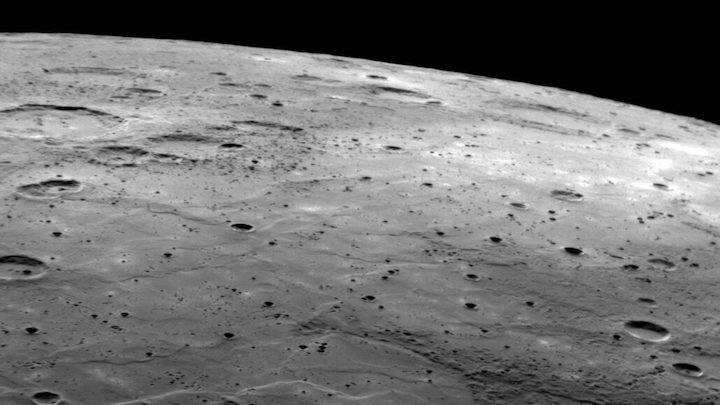23.03.2022
Billions of years of impacts may have turned much of a graphite crust into precious gemstones

A persistent barrage of meteorite impacts may have turned some of the surface of Mercury (pictured) into diamond, computer simulations suggest.
NASA, JOHNS HOPKINS UNIVERSITY APPLIED PHYSICS LABORATORY, CARNEGIE INSTITUTION OF WASHINGTON
A treasure trove of diamonds may be sown into Mercury’s cratered crust.
Billions of years of meteorite impacts may have flash-baked much of Mercury’s surface into the glittery gemstones, planetary scientist Kevin Cannon reported March 10 at the Lunar and Planetary Science Conference in The Woodlands, Texas. His computer simulations predict that such impacts may have transformed about one-third of the little planet’s crust into a diamond stockpile many times that of Earth’s.
Diamonds are forged under immense pressures and temperatures. On Earth, the gemstones crystallize deep underground — at least 150 kilometers down — then ride to the surface during volcanic eruptions (SN: 9/14/20). But studies of meteorites suggest diamonds can also form during impact.
“When those [impacts] happen, they create very high pressures and temperatures that can transform carbon into diamond,” says Cannon, of the Colorado School of Mines in Golden.
With impact-born diamonds on his mind, Cannon turned to the closest planet to the sun. Surveys of the planet’s surface and experiments with molten rock suggest that the planet’s crust may retain fragments of an old shell of graphite — a mineral made from carbon (SN: 3/7/16). “What we think happened is that when [Mercury] first formed, it had a magma ocean, and that graphite crystallized out of that magma,” Cannon says.
Then, the bombardment. Mercury’s surface today is heavily cratered, evidence of an impact-rich history. Much of the purported graphite crust would have been battered and transformed into diamond, Cannon hypothesized.
Curious how pervasive this diamond forging could have been, Cannon used computers to simulate 4.5 billion years of impacts on a graphite crust. The findings show that if Mercury had possessed a skin of graphite 300 meters thick, the battering would have generated 16 quadrillion tons of diamonds — about 16 times Earth’s estimated reserves.
“There’s no reason to doubt that diamonds could be produced in this way,” says Simone Marchi, a planetary scientist at the Southwest Research Institute in Boulder, Colo., who was not involved with the research. But how many might have survived, that’s another story, he says. Some of the gemstones would probably have been destroyed by later impacts.
Cannon agrees that subsequent impacts would probably obliterate some diamonds. But the losses would have been “very limited,” he says, as the ultimate melting point of diamond exceeds 4000° Celsius. Future simulations will incorporate remelting from impacts, he says, to refine the potential size of Mercury’s present day diamond reserves.
An opportunity to scout for diamonds on Mercury may come in 2025, when the BepiColombo mission reaches the planet. Diamonds reflect a distinct signature of infrared light, Cannon says. “And potentially, this could be detected.”
